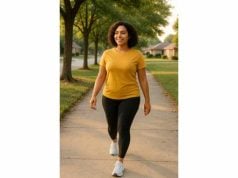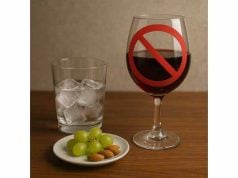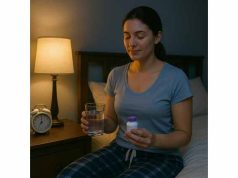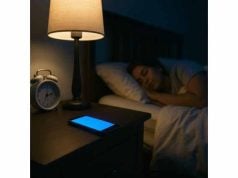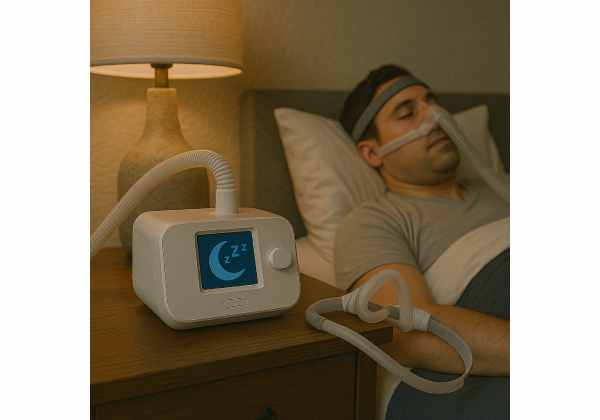
Sleep apnea can quietly block weight loss. Poor sleep drives appetite higher, drains energy for movement, and disrupts hormones that regulate hunger and fullness. Treating apnea does not replace nutrition or exercise—but it removes a major brake so your plan actually works. This guide explains how to recognize signs, get tested, choose treatment, and integrate your device with a sustainable weight loss routine. You will also get practical schedules and troubleshooting steps for real life. For a quick foundation that ties habits, sleep, and stress together, see our concise guide to habit and recovery basics for weight loss.
Table of Contents
- Sleep apnea and weight loss basics
- Signs you should not ignore
- Testing: home or lab?
- Treatment that supports weight loss
- Mistakes that stall progress
- Safety and red flags
- Evidence, metrics and timeline
- Frequently asked questions
Sleep apnea and weight loss basics
What sleep apnea is: During sleep, the airway collapses or becomes blocked. Breathing slows or pauses, oxygen dips, and the brain briefly wakes you to reopen the airway. This can happen dozens of times per hour. You may not remember the awakenings, but your sleep becomes fragmented and shallow.
Why it blocks weight loss:
- Hunger signals shift. Short, broken sleep increases appetite and sweet cravings while dulling satiety. That combination makes “just eat less” much harder to execute.
- Daytime energy drops. Low energy reduces spontaneous movement and workout intensity, shrinking your daily calorie burn without you noticing.
- Stress physiology rises. Repeated oxygen dips act like stressors, pushing cortisol up and nudging the body toward storing rather than spending energy.
- Metabolic effects stack. Blood sugar control worsens, and insulin resistance increases. That does not make fat loss impossible, but it adds friction to every choice.
What treatment changes: Effective therapy (usually a PAP device or an oral appliance) stabilizes breathing so sleep becomes deeper and more continuous. People often report less afternoon hunger, fewer night-time cravings, brighter mood, and more willingness to move. Those improvements compound: better sleep supports better choices, which support better sleep.
Weight and apnea influence each other. Extra neck and tongue-base tissue can narrow the airway. Conversely, untreated apnea increases fatigue and appetite, which can drive weight gain. Breaking that loop requires addressing both sleep and lifestyle. Many people find that even modest weight loss lowers apnea severity; conversely, using a device first often makes the nutrition plan finally sustainable.
A simple plan that works:
- Screen for apnea if you have key symptoms (see Section 2).
- Get a sleep study (home or lab) and start treatment.
- Build a steady routine of protein-forward meals, short daily walks, and stress limits.
- Track one progress metric you can stick with (e.g., weekly weight trend or “green meals” per day).
- After treatment is stable, review options for further improvements (weight, positional therapy, nasal care).
If your goal is healthy, steady fat loss, pair apnea care with a straightforward roadmap like our safe weight loss steps so your daily behaviors pull in the same direction as your treatment.
Bottom line: Treating sleep apnea does not do the work for you—it removes the handbrake so the work you do starts to show.
Signs you should not ignore
You do not need to snore loudly every night to have sleep apnea. Many people minimize symptoms as “just being tired” or “I’m a bad sleeper,” but certain patterns are red flags.
Classic night signs
- Loud, habitual snoring that others can hear through a door.
- Breathing pauses, gasping, or choking during sleep (often noticed by a partner).
- Restless sleep with frequent awakenings and position changes.
- Waking with a dry mouth, sore throat, or morning headache.
- Frequent urination at night (nocturia), not fully explained by fluid intake.
Daytime clues
- Sleepiness during routine tasks (meetings, TV, reading).
- Brain fog, irritability, or low mood.
- Morning “hungover” feeling even without alcohol.
- Dozing at traffic lights or needing naps to function.
Risk factors that add up
- Neck circumference on the larger side for your body size.
- Weight gain (especially around the neck and midsection).
- Family history of snoring or apnea.
- Nasal congestion, allergies, or a chronically stuffy nose.
- Jaw or airway anatomy (retrognathia, small chin, enlarged tonsils).
- Men and postmenopausal women have higher risk, but anyone can have apnea, including lean people and children.
Self-check tools (not diagnostic)
- Ask a bed partner to note snoring intensity and breathing pauses for a week.
- Track midday sleepiness and near-miss drowsy driving incidents—these are significant safety warnings.
- Notice late-night hunger or sugar cravings. Poor sleep often makes evening eating harder to control; our quick primer on sleep and appetite signals explains why.
When to test now: If you snore most nights, wake unrefreshed, or feel sleepy while driving, get evaluated. If you have high blood pressure, type 2 diabetes, atrial fibrillation, or resistant hypertension, screening for apnea is especially important because treatment can improve these conditions.
A note about stigma: Apnea is not a personal failing. It is a mechanical issue—an airway that narrows when muscles relax. Devices and oral appliances are tools, like glasses for vision. Most people feel better within days to weeks when therapy is dialed in.
Testing: home or lab?
Sleep apnea is confirmed by a sleep study that measures breathing events and oxygen levels. Two main options exist: home sleep apnea testing (HSAT) and in-lab polysomnography (PSG). Both can be effective when chosen for the right situation.
Home sleep apnea test (HSAT)
- What it is: A small kit you wear overnight at home. It typically measures airflow, breathing effort, and oxygen saturation.
- Pros: Comfortable, done in your own bed, usually faster to schedule, less expensive.
- Cons: Less data than a lab study (no full brain-wave sleep staging). Can miss central apnea, REM-related apnea, or milder cases.
- Best for: People with a high likelihood of moderate-to-severe obstructive apnea and without major heart, lung, or neuromuscular disease.
In-lab polysomnography (PSG)
- What it is: An overnight study in a sleep lab with sensors for brain waves, eye movements, muscle tone, airflow, breathing effort, oxygen, and sometimes CO₂.
- Pros: Gold standard; best for complex cases, suspected central apnea, limb movements, parasomnias, or when a prior HSAT was negative but symptoms persist. Can include CPAP titration to find a helpful pressure.
- Cons: Less convenient, more expensive, and scheduling can take longer.
Understanding your report (plain language)
- Apnea–Hypopnea Index (AHI): Breathing events per hour of sleep.
- Mild: 5–14
- Moderate: 15–29
- Severe: 30+
- Oxygen saturation (SpO₂): Note the nadir (lowest value) and time spent under 90%.
- Positional effects: Worse events on your back (supine) vs. side.
- REM-related apnea: Events cluster during dream sleep.
What happens after the test
- If positive, your clinician will discuss therapy options: CPAP/APAP, oral appliance, positional therapy, nasal care, and lifestyle steps.
- If negative but symptoms remain strong, a lab study may be recommended to catch subtler patterns.
- If your oxygen dips without many airway events, your clinician will look for other causes (lung or heart issues).
How testing supports weight loss
- A clear diagnosis motivates follow-through—people stick with treatment when they understand the “why.”
- Effective therapy improves sleep depth and daytime energy, which reduces cravings and makes planned meals and short walks easier to do. For broader context on sleep quantity and appetite, see our guide to how much sleep supports weight loss.
Practical tips
- Do not delay because you hope to lose weight first. Treating apnea now helps weight loss happen.
- If you shift work, tell the lab so they can align testing with your sleep window (and read our shift work strategies if nights are your norm).
Treatment that supports weight loss
The best treatment is the one you will actually use, delivers deep sleep, and fits your life. Here is what to know about the main options and how to integrate them with a weight loss plan.
CPAP and APAP (positive airway pressure)
- What they do: Keep the airway open with a gentle column of air through a mask. APAP adjusts pressure automatically; CPAP uses a fixed pressure.
- Why they help weight loss: Deeper, more continuous sleep lowers hunger and stabilizes energy. People often find late-night snacking drops within the first weeks.
- Getting the fit right: Try different masks (nasal pillow, nasal, full-face). Small adjustments in headgear, cushion size, and humidity can transform comfort.
- Adherence goal: Aim for 4+ hours per night on most nights as an early milestone; many feel best at 6–7+ hours.
Mandibular advancement devices (oral appliances)
- What they do: A custom dental device brings the lower jaw forward to widen the airway.
- Best for: Mild to moderate obstructive apnea, or for people who cannot tolerate PAP.
- Notes: Requires fitting and follow-up; sometimes combined with positional therapy.
Positional therapy
- What it is: Strategies or devices that keep you off your back if apnea is mostly supine-dependent.
- Use case: Effective adjunct for people whose studies show big differences between back and side sleep.
Nasal care and congestion management
- Why it matters: Open nasal passages reduce mouth leaks on PAP and make oral appliances more comfortable. Consider saline rinses, heated humidity, and allergy management as advised.
Weight loss and airway health
- Even a modest weight loss can lower AHI for many people. But do not wait for weight changes to treat apnea. Use therapy first, then layer in nutrition and movement.
Integrate therapy with your routine
- Establish a consistent bedtime wind-down (dim lights, cool room, brush teeth, device on). A short routine lowers the barrier to using your equipment nightly. For specific steps, skim our guide to a practical bedtime routine.
- Pair device setup with a calming cue (quiet music, breathing practice).
- Keep backup supplies ready (extra cushions, distilled water if needed) so minor issues do not break streaks.
Measuring success
- Subjective: less daytime sleepiness, clearer focus, fewer headaches, fewer night-time awakenings.
- Objective: device usage hours, mask leak rates, residual AHI. Review data with your team, then adjust.
Mistakes that stall progress
Most “CPAP failures” are fixable logistics. Here are common blockers and simple remedies so you keep momentum in both sleep and weight loss.
Going it alone after setup
- Mistake: Accepting the first mask/pressure forever.
- Fix: Request a follow-up within two to four weeks. Try multiple mask styles; tiny changes in size or cushion type can eliminate leaks and pressure points.
Ignoring the nose
- Mistake: Fighting mouth leaks and dryness nightly.
- Fix: Use heated humidity and consider saline rinses before bed. If allergies are strong, ask about medical options. A comfortable nose improves adherence dramatically.
Late caffeine and alcohol
- Mistake: Coffee after mid-afternoon or regular nightcaps. Both fragment sleep and intensify cravings the next day.
- Fix: Set a caffeine cutoff 8–10 hours before bedtime and shrink alcohol to planned occasions. For specifics, see our guides to caffeine timing and lower-calorie alcohol habits.
“I’ll lose weight first, then treat apnea”
- Mistake: Delaying care until after weight loss. Untreated apnea makes fat loss harder.
- Fix: Treat first. Most people find nutrition and movement are easier once sleep improves.
Unplanned late-night eating
- Mistake: Pantry raids while sleepy, especially on nights when the mask feels fussy.
- Fix: Close the kitchen after dinner with a planned sweet finish (e.g., Greek yogurt and berries) or herbal tea. If cravings persist, review our focused strategies to end late-night snacking.
Overhauling everything at once
- Mistake: New device + strict diet + daily hard workouts. Burnout follows.
- Fix: Pick three anchors for the first month: nightly therapy, protein-forward meals, and a 10-minute walk after your largest meal. Add from there.
Data obsession
- Mistake: Checking weight and device stats compulsively.
- Fix: Track a weekly weight trend and device hours/leaks at a set check-in. The goal is steady direction, not daily perfection.
Safety and red flags
Apnea intersects with other health issues. The right precautions keep you safe while you build new habits.
Driving and heavy machinery
- If you are sleepy while driving, do not drive until treatment reduces daytime sleepiness. Plan carpools or public transit briefly. Safety first.
When to call your clinician quickly
- Persistent chest pain, new severe breathlessness, or irregular heartbeats.
- Morning headaches that worsen on therapy or frequent oxygen dips on device reports.
- Severe mask intolerance with air hunger—may indicate central apnea or the need for different settings.
Medical conditions to flag
- Heart failure, COPD, neuromuscular disease, opioid use, or prior stroke: These raise the chance of central apnea or complex patterns that need lab-based evaluation and specific device modes.
- Pregnancy: Snoring often increases. Discuss testing and safe treatment options with your obstetric provider.
If CPAP worsens sleep at first
- This can happen during acclimation. Use ramp features, start with short “on-the-couch” sessions while reading, and lengthen nightly use. If sleep continues to feel worse after two weeks, request a review of settings and mask fit.
Support matters
- Involve a partner or friend in your setup routine and progress check-ins. A simple message—“device on by 10:30”—can help adherence. If you thrive with community, our guide on building a support system can make new habits stick.
Bottom line: Most obstacles are solvable. When in doubt, ask for help early—small adjustments prevent months of frustration.
Evidence, metrics and timeline
You work better with a plan and a clock. Use a simple dashboard and a realistic timeline so you can see progress even when the scale moves slowly.
Pick two primary metrics and one secondary
- Primary: device hours per night (target: consistent use), weekly weight trend, or “green meals” per day (meals that hit protein + plate method).
- Secondary: waist measurement every two weeks, morning energy rating (1–5), or number of afternoon crashes per week.
How to weigh without obsession
- Weigh at the same time of day (e.g., mornings three times per week), then average weekly. Expect normal ups and downs from salt, travel, and menstrual cycles.
A realistic results timeline
- Week 1–2: Sleep continuity improves; morning fog lifts. Late-night cravings ease a bit. You feel more willing to take short walks.
- Week 3–6: Energy stabilizes; adherence gets easier. You notice fewer afternoon crashes and steadier appetite. Clothing may fit better as water and bloat settle.
- Week 7–12: Weight trend becomes clearer if protein-forward meals and regular movement are in place. Some people reduce pressure needs or mask size as swelling and congestion improve.
- Beyond 12 weeks: Consider refinements—positional therapy, nasal care upgrades, or targeted weight changes.
Proof you are on track (even before the scale)
- You wake before your alarm some days.
- You fall asleep faster with the device on.
- You crave sweets less at night.
- You complete a 10-minute walk without bargaining.
When to adjust
- Hunger high despite therapy? Add 10–20 g protein to lunch and dinner and ensure a fist of starch at the meal before your hungriest period.
- Energy flat? Move your largest, balanced meal earlier in your wake period and schedule daylight exposure.
- Adherence shaky? Simplify: keep the device and one eating anchor; pause new goals for a week.
For gentle, numbers-light tracking, our approach to trend-based weigh-ins can help you see progress without fixation.
Frequently asked questions
Can treating sleep apnea help me lose weight?
Treating apnea improves sleep quality, which often reduces cravings, stabilizes energy, and makes movement easier. Therapy does not directly burn fat, but it removes barriers that sabotage diet and exercise. Many people find their plan becomes sustainable once sleep is consistently better.
Do I need a lab study, or is a home test enough?
Home tests work well for suspected obstructive apnea without major medical complications. If symptoms are strong but a home test is negative—or if central apnea or other sleep disorders are likely—an in-lab study gives fuller data and may include CPAP titration the same night.
How long before I feel better on CPAP?
Some notice improvement in a few nights; most feel steadier energy within two to four weeks as settings and mask fit are optimized. Use the device every sleep period, including naps, and schedule an early follow-up to fix leaks, dryness, or pressure issues quickly.
Can weight loss cure sleep apnea?
Weight loss can reduce apnea severity and, in some cases, resolve mild disease. Yet anatomy, nasal congestion, and sleep position still matter. Treat apnea now to sleep better while you work on weight; reassess after progress to see if therapy adjustments are appropriate.
What if I cannot tolerate the mask?
Do not give up on first fit. Try different mask types (nasal pillow, nasal, full-face), adjust humidity and ramp, and practice with the mask while awake. If PAP remains intolerable, discuss oral appliances or combined approaches with your clinician.
Is it safe to drive if I feel sleepy?
No. Daytime sleepiness increases accident risk. Avoid driving until treatment reduces sleepiness, arrange alternative transport temporarily, and talk with your clinician about expediting adjustments so you can return to driving safely.
References
- Obstructive sleep apnoea/hypopnoea syndrome and obesity hypoventilation syndrome in over 16s — 2021 (Guideline)
- Treatment of Adult Obstructive Sleep Apnea with Positive Airway Pressure: An American Academy of Sleep Medicine Clinical Practice Guideline — 2019 (Guideline)
- Clinical Practice Guideline for Diagnostic Testing for Adult Obstructive Sleep Apnea: An American Academy of Sleep Medicine Clinical Practice Guideline — 2017 (Guideline)
- Tirzepatide for the Treatment of Obstructive Sleep Apnea and Obesity — 2024 (RCT)
- Weight reduction and the impact on apnea-hypopnea index: A systematic meta-analysis — 2024 (Systematic Review)
Disclaimer
This article offers general education and is not a substitute for professional medical advice, diagnosis, or treatment. Sleep apnea and its therapies can interact with heart, lung, neurological, and metabolic conditions. Always consult your physician or a sleep specialist for testing and individualized guidance, especially if you experience daytime drowsy driving, severe snoring, or oxygen drops.
If this guide helped, consider sharing it with someone who wakes unrefreshed or struggles with night cravings, and follow us on Facebook, X, or whichever network you use to see practical sleep, nutrition, and movement guides that support long-term weight loss.

